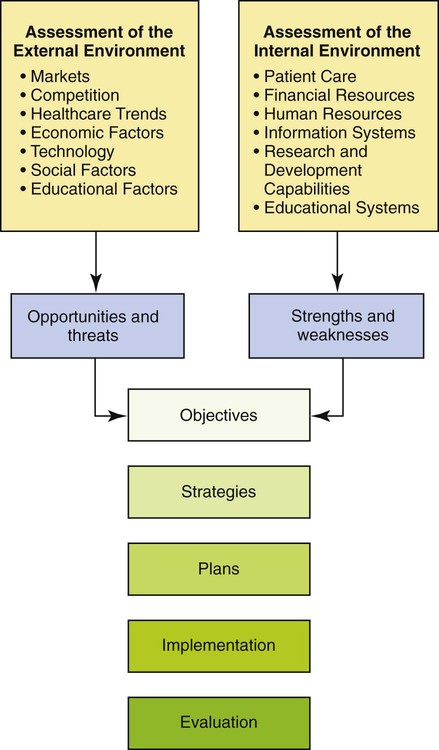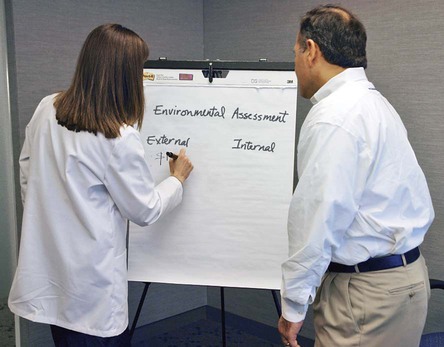• Articulate the value and importance of conducting an environmental assessment. • Explore the planning process. • Review the purpose of a mission statement, a philosophy, and established goals and objectives. • Apply goal-setting and strategic planning. • Explain the process of strategic planning in establishing a product line in an acute care setting. • Ensuring care across the continuum that is both coordinated and comprehensive • Securing appropriate utilization of resources, advanced technology, and work force Nurses are instrumental in the development of planning and executing new strategies for the future and thus in influencing the direction of health care. As technology advances, it is paramount for nurses to be at the forefront of this paradigm shift. This paradigm shift will require nurses to embrace, apply, and evaluate the use of such new technology. By demonstrating our ability to adopt and use new technology, we will be able to provide nursing with the expertise and earn the credibility to serve as advisors, directors, and influencers of technology. Thus, by our active participation and expertise, we can ensure that technology will be used to meet nursing’s information needs, to advance nursing practice, and to ensure nursing’s continued viability. In the twenty-first century, technology has a strong influence on leaders and organizations (Mayo & Nohria, 2005). The strategic planning process shown in Figure 16-1 consists of the following series of steps: • Search the internal, external, and organizational environment to determine those forces or changes that may affect the work of the organization or that may be crucial to its survival. • Analyze the organization’s strengths, weaknesses, opportunities, threats (SWOT analysis) and its potential for dealing with change. • Develop and evaluate the various strategies available to the organization to meet these opportunities and threats. • Revise organizational mission, philosophy, goals, and objectives based on the above • Select the best strategic option that balances the organization’s potential with the challenges of changing conditions, taking into account the values of its management and its social responsibilities. The strategic planning process is proactive, vision-directed, action-oriented, creative, innovative, and oriented toward positive change. For a strategic plan to succeed, a system must be developed that creates a business plan for each approved initiative; this plan is integrated with a financial plan so that resources can be allocated and time for implementation and the required capital resources can be determined (Ruder & O’Connor, 2007). According to Kaplan and Norton (2005), many organizations have great ambitions for growth but very few ever realize it because they are disconnected from execution (implementation) of their plan. Visionary leaders ensure that those around them understand the direction the organization is going (Ibarra & Obodaru, 2009). These visionaries search for a new path through a vigorous dialog with various constituents, both internally and externally, because great visions will not actualize from solitary analysis (Ibarra & Obodaru, 2009). It is also important that futuristic leaders test their vision practically against current resources from the following perspectives: financial, human resources, and the overall organizational capabilities (Ibarra & Obodaru, 2009). True strategists provide an organization with more than a vision statement—they can articulate it and have the organization respond to it (Ibarra & Obodaru, 2009). Although strategic planning is often achieved at the executive level of an organization, staff and managers provide a valuable perspective. In addition, managers and staff may be engaged in a clinical strategic planning process. Assessment of the external environment is the initial phase in the strategic-planning process. The economic, demographic, technologic, social-cultural, educational, and political-legal factors are assessed in terms of their impact on opportunities and threats within the environment. Healthcare leaders can assess the effect of competitors on their environment, thus plan and monitor their own operations, and develop other creative and visionary programs as they work within the framework of their institutional mission and goals. Coyne and Horn (2009) suggested that leaders of an organization must anticipate how their competitors might respond to the strategic plan. Once that is known, the response can be incorporated into the plan. An example appears in Box 16-1. Covey (1990) identified that the mission statement is vital to the success of an organization and believes that everyone should participate in the development of the mission statement: “The involvement process is as important as the written product and is the key to its use” (p. 139). “An organizational mission statement, one that truly reflects the deep shared vision and values of everyone within that organization, creates a unity and tremendous commitment” (p. 143). Goal-setting is the process of developing, negotiating, and formalizing the targets or objectives of an organization. If goals are not appropriate to the organization, frustration and poor performance could result (Hader, 2008). Using the example from Box 16-1, the joint replacement program might have five goals: 1. Provide comprehensive patient/family education across the continuum of care. 2. Develop protocols for standardized patient care programs in terms of activities of daily living, physical and occupational therapy, recreational exercise, and pain management. 3. Incorporate a multidisciplinary approach to patient care through the use of physicians, nurse practitioners, nurses, case managers, social workers, physical and occupational therapists, dietitians, home care personnel, and clergy. 4. Enhance community support programs for arthritic patients. 5. Ensure that the website is current, with information and services available to patients. Four key steps in implementing a goal-setting program are as follows: Specific The objective statement is properly constructed and describes exactly what is to be accomplished. • It begins with the word to, followed by an action verb. • It specifies a single result to be achieved. Measurable The objectives are measurable. Agreed On The objectives are agreed on by all parties. Realistic The objectives must be created within the realm of possibility and a challenge. • The objectives should not be unrealistic or unattainable. • They must be written in the span of control for the specific team working toward the goals. Time Bound The objectives should establish a time frame for which the activity or improvement must be achieved. • Timelines and deadlines are adhered to. • The time line must be well-defined by avoiding statements such as “in the future.”
Strategic Planning, Goal-Setting, and Marketing

Strategic Planning

Phases of the Strategic Planning Process
Phase 1: Assessment of the External and Internal Environment
External Environmental Assessment
Phase 2: Review of Mission Statement, Philosophy, Goals, and Objectives
Mission Statement
Goal-Setting
Objectives
![]()
Stay updated, free articles. Join our Telegram channel

Full access? Get Clinical Tree



Strategic Planning, Goal-Setting, and Marketing
Get Clinical Tree app for offline access
